Sihao Lin
Learning A Zero-shot Occupancy Network from Vision Foundation Models via Self-supervised Adaptation
Mar 10, 2025Abstract:Estimating the 3D world from 2D monocular images is a fundamental yet challenging task due to the labour-intensive nature of 3D annotations. To simplify label acquisition, this work proposes a novel approach that bridges 2D vision foundation models (VFMs) with 3D tasks by decoupling 3D supervision into an ensemble of image-level primitives, e.g., semantic and geometric components. As a key motivator, we leverage the zero-shot capabilities of vision-language models for image semantics. However, due to the notorious ill-posed problem - multiple distinct 3D scenes can produce identical 2D projections, directly inferring metric depth from a monocular image in a zero-shot manner is unsuitable. In contrast, 2D VFMs provide promising sources of relative depth, which theoretically aligns with metric depth when properly scaled and offset. Thus, we adapt the relative depth derived from VFMs into metric depth by optimising the scale and offset using temporal consistency, also known as novel view synthesis, without access to ground-truth metric depth. Consequently, we project the semantics into 3D space using the reconstructed metric depth, thereby providing 3D supervision. Extensive experiments on nuScenes and SemanticKITTI demonstrate the effectiveness of our framework. For instance, the proposed method surpasses the current state-of-the-art by 3.34% mIoU on nuScenes for voxel occupancy prediction.
TransMamba: Fast Universal Architecture Adaption from Transformers to Mamba
Feb 21, 2025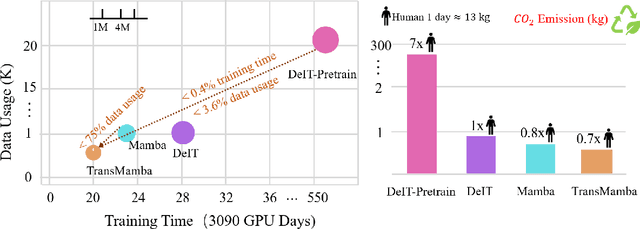
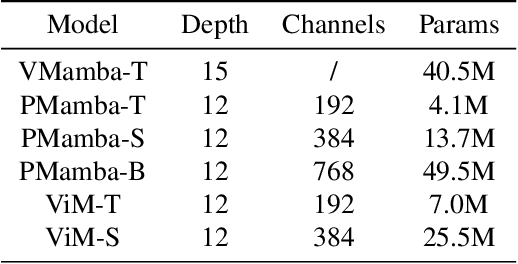
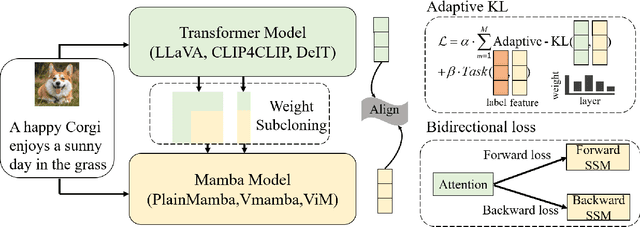
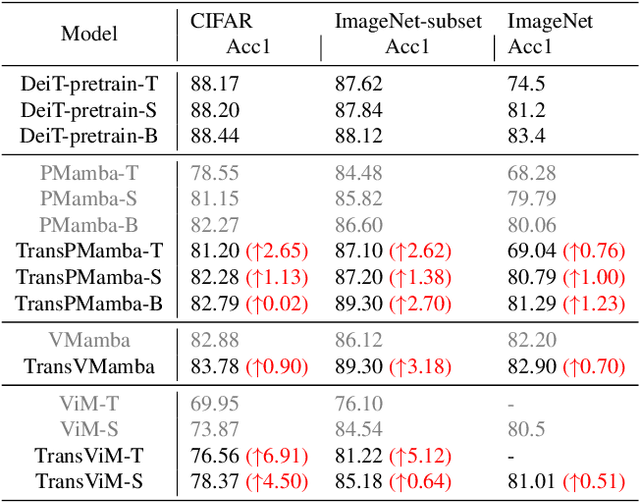
Abstract:Transformers have been favored in both uni-modal and multi-modal foundation models for their flexible scalability in attention modules. Consequently, a number of pre-trained Transformer models, e.g., LLaVA, CLIP, and DEIT, are publicly available. Recent research has introduced subquadratic architectures like Mamba, which enables global awareness with linear complexity. Nevertheless, training specialized subquadratic architectures from scratch for certain tasks is both resource-intensive and time-consuming. As a motivator, we explore cross-architecture training to transfer the ready knowledge in existing Transformer models to alternative architecture Mamba, termed TransMamba. Our approach employs a two-stage strategy to expedite training new Mamba models, ensuring effectiveness in across uni-modal and cross-modal tasks. Concerning architecture disparities, we project the intermediate features into an aligned latent space before transferring knowledge. On top of that, a Weight Subcloning and Adaptive Bidirectional distillation method (WSAB) is introduced for knowledge transfer without limitations on varying layer counts. For cross-modal learning, we propose a cross-Mamba module that integrates language awareness into Mamba's visual features, enhancing the cross-modal interaction capabilities of Mamba architecture. Despite using less than 75% of the training data typically required for training from scratch, TransMamba boasts substantially stronger performance across various network architectures and downstream tasks, including image classification, visual question answering, and text-video retrieval. The code will be publicly available.
Making Large Language Models Better Planners with Reasoning-Decision Alignment
Aug 25, 2024Abstract:Data-driven approaches for autonomous driving (AD) have been widely adopted in the past decade but are confronted with dataset bias and uninterpretability. Inspired by the knowledge-driven nature of human driving, recent approaches explore the potential of large language models (LLMs) to improve understanding and decision-making in traffic scenarios. They find that the pretrain-finetune paradigm of LLMs on downstream data with the Chain-of-Thought (CoT) reasoning process can enhance explainability and scene understanding. However, such a popular strategy proves to suffer from the notorious problems of misalignment between the crafted CoTs against the consequent decision-making, which remains untouched by previous LLM-based AD methods. To address this problem, we motivate an end-to-end decision-making model based on multimodality-augmented LLM, which simultaneously executes CoT reasoning and carries out planning results. Furthermore, we propose a reasoning-decision alignment constraint between the paired CoTs and planning results, imposing the correspondence between reasoning and decision-making. Moreover, we redesign the CoTs to enable the model to comprehend complex scenarios and enhance decision-making performance. We dub our proposed large language planners with reasoning-decision alignment as RDA-Driver. Experimental evaluations on the nuScenes and DriveLM-nuScenes benchmarks demonstrate the effectiveness of our RDA-Driver in enhancing the performance of end-to-end AD systems. Specifically, our RDA-Driver achieves state-of-the-art planning performance on the nuScenes dataset with 0.80 L2 error and 0.32 collision rate, and also achieves leading results on challenging DriveLM-nuScenes benchmarks with 0.82 L2 error and 0.38 collision rate.
MLP Can Be A Good Transformer Learner
Apr 08, 2024Abstract:Self-attention mechanism is the key of the Transformer but often criticized for its computation demands. Previous token pruning works motivate their methods from the view of computation redundancy but still need to load the full network and require same memory costs. This paper introduces a novel strategy that simplifies vision transformers and reduces computational load through the selective removal of non-essential attention layers, guided by entropy considerations. We identify that regarding the attention layer in bottom blocks, their subsequent MLP layers, i.e. two feed-forward layers, can elicit the same entropy quantity. Meanwhile, the accompanied MLPs are under-exploited since they exhibit smaller feature entropy compared to those MLPs in the top blocks. Therefore, we propose to integrate the uninformative attention layers into their subsequent counterparts by degenerating them into identical mapping, yielding only MLP in certain transformer blocks. Experimental results on ImageNet-1k show that the proposed method can remove 40% attention layer of DeiT-B, improving throughput and memory bound without performance compromise. Code is available at https://github.com/sihaoevery/lambda_vit.
Self-Supervised Multi-Frame Neural Scene Flow
Mar 24, 2024



Abstract:Neural Scene Flow Prior (NSFP) and Fast Neural Scene Flow (FNSF) have shown remarkable adaptability in the context of large out-of-distribution autonomous driving. Despite their success, the underlying reasons for their astonishing generalization capabilities remain unclear. Our research addresses this gap by examining the generalization capabilities of NSFP through the lens of uniform stability, revealing that its performance is inversely proportional to the number of input point clouds. This finding sheds light on NSFP's effectiveness in handling large-scale point cloud scene flow estimation tasks. Motivated by such theoretical insights, we further explore the improvement of scene flow estimation by leveraging historical point clouds across multiple frames, which inherently increases the number of point clouds. Consequently, we propose a simple and effective method for multi-frame point cloud scene flow estimation, along with a theoretical evaluation of its generalization abilities. Our analysis confirms that the proposed method maintains a limited generalization error, suggesting that adding multiple frames to the scene flow optimization process does not detract from its generalizability. Extensive experimental results on large-scale autonomous driving Waymo Open and Argoverse lidar datasets demonstrate that the proposed method achieves state-of-the-art performance.
FULLER: Unified Multi-modality Multi-task 3D Perception via Multi-level Gradient Calibration
Jul 31, 2023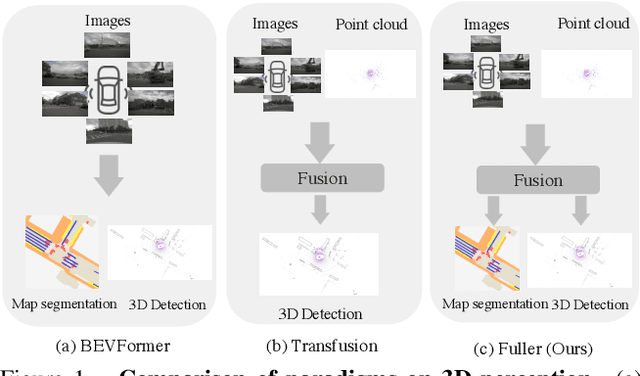
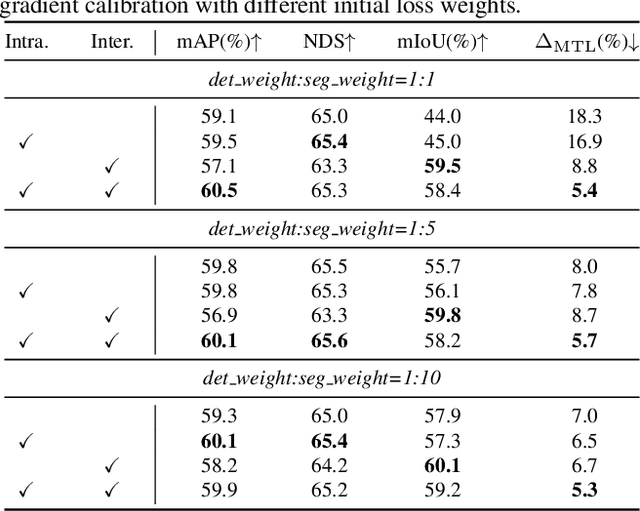

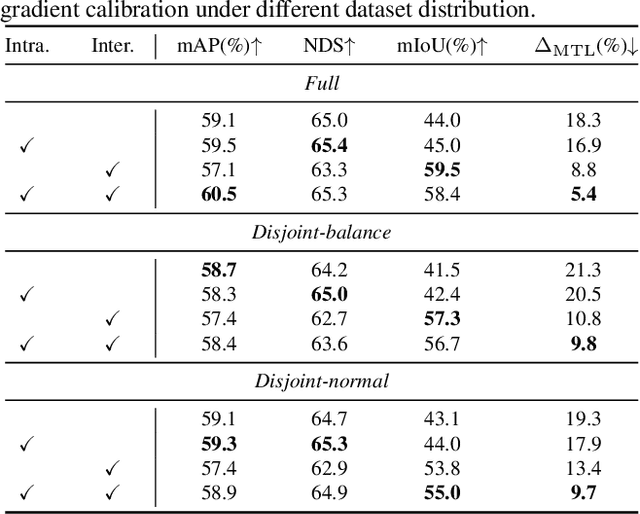
Abstract:Multi-modality fusion and multi-task learning are becoming trendy in 3D autonomous driving scenario, considering robust prediction and computation budget. However, naively extending the existing framework to the domain of multi-modality multi-task learning remains ineffective and even poisonous due to the notorious modality bias and task conflict. Previous works manually coordinate the learning framework with empirical knowledge, which may lead to sub-optima. To mitigate the issue, we propose a novel yet simple multi-level gradient calibration learning framework across tasks and modalities during optimization. Specifically, the gradients, produced by the task heads and used to update the shared backbone, will be calibrated at the backbone's last layer to alleviate the task conflict. Before the calibrated gradients are further propagated to the modality branches of the backbone, their magnitudes will be calibrated again to the same level, ensuring the downstream tasks pay balanced attention to different modalities. Experiments on large-scale benchmark nuScenes demonstrate the effectiveness of the proposed method, eg, an absolute 14.4% mIoU improvement on map segmentation and 1.4% mAP improvement on 3D detection, advancing the application of 3D autonomous driving in the domain of multi-modality fusion and multi-task learning. We also discuss the links between modalities and tasks.
Knowledge Distillation via the Target-aware Transformer
May 22, 2022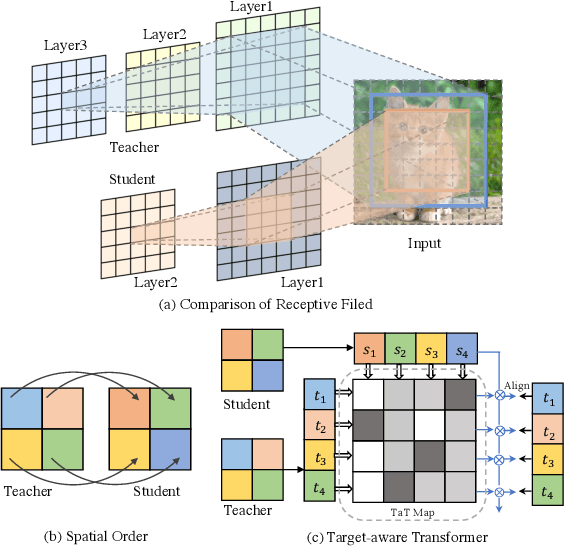
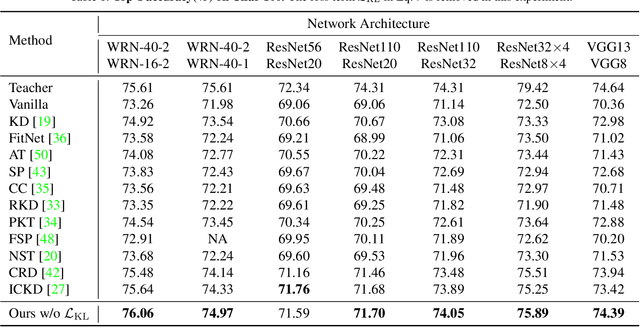


Abstract:Knowledge distillation becomes a de facto standard to improve the performance of small neural networks. Most of the previous works propose to regress the representational features from the teacher to the student in a one-to-one spatial matching fashion. However, people tend to overlook the fact that, due to the architecture differences, the semantic information on the same spatial location usually vary. This greatly undermines the underlying assumption of the one-to-one distillation approach. To this end, we propose a novel one-to-all spatial matching knowledge distillation approach. Specifically, we allow each pixel of the teacher feature to be distilled to all spatial locations of the student features given its similarity, which is generated from a target-aware transformer. Our approach surpasses the state-of-the-art methods by a significant margin on various computer vision benchmarks, such as ImageNet, Pascal VOC and COCOStuff10k. Code will be released soon.
Exploring Inter-Channel Correlation for Diversity-preserved KnowledgeDistillation
Feb 08, 2022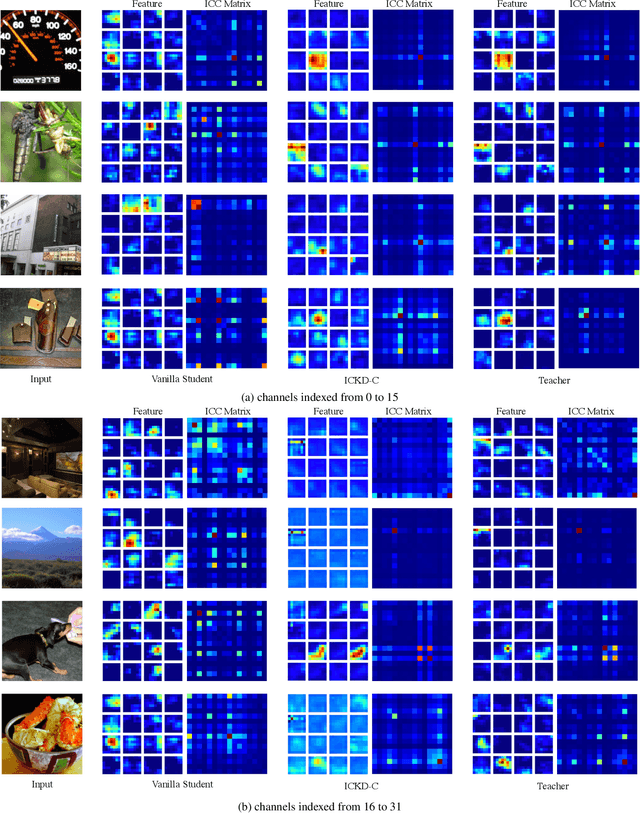
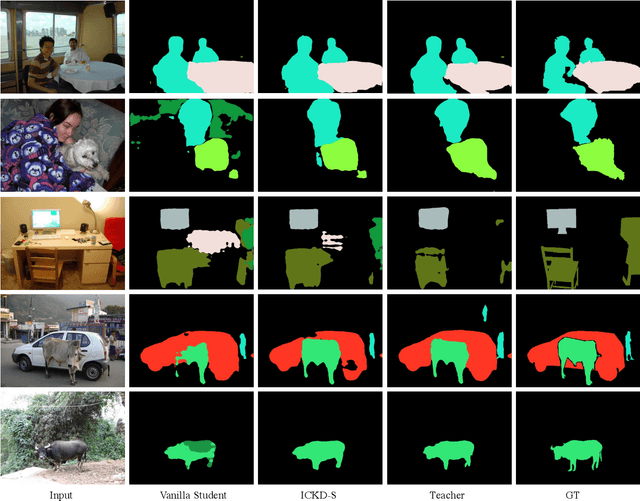
Abstract:Knowledge Distillation has shown very promising abil-ity in transferring learned representation from the largermodel (teacher) to the smaller one (student).Despitemany efforts, prior methods ignore the important role ofretaining inter-channel correlation of features, leading tothe lack of capturing intrinsic distribution of the featurespace and sufficient diversity properties of features in theteacher network.To solve the issue, we propose thenovel Inter-Channel Correlation for Knowledge Distillation(ICKD), with which the diversity and homology of the fea-ture space of the student network can align with that ofthe teacher network. The correlation between these twochannels is interpreted as diversity if they are irrelevantto each other, otherwise homology. Then the student isrequired to mimic the correlation within its own embed-ding space. In addition, we introduce the grid-level inter-channel correlation, making it capable of dense predictiontasks. Extensive experiments on two vision tasks, includ-ing ImageNet classification and Pascal VOC segmentation,demonstrate the superiority of our ICKD, which consis-tently outperforms many existing methods, advancing thestate-of-the-art in the fields of Knowledge Distillation. Toour knowledge, we are the first method based on knowl-edge distillation boosts ResNet18 beyond 72% Top-1 ac-curacy on ImageNet classification. Code is available at:https://github.com/ADLab-AutoDrive/ICKD.
 Add to Chrome
Add to Chrome Add to Firefox
Add to Firefox Add to Edge
Add to Edge